ASUS P8Z68-V PRO Review: Our First Z68 Motherboard
by Ian Cutress on May 11, 2011 3:13 AM EST- Posted in
- Motherboards
- Asus
- Z68
3D Movement Algorithm Test
The first benchmark ran is actually one I have written. My full time job involves computational chemistry, so this first benchmark uses various algorithms for three-dimensional simulation and movement of independent particles. The algorithms both employ uniform random number generation or normal distribution random number generation, and vary in various amounts of trigonometric operations, conditional statements, generation and rejection, fused operations, etc. The benchmark runs through six algorithms for a specified number of particles and steps, and calculates the speed of each algorithm, then sums them all for a final score. This is an example of a real world situation that a computational scientist may find themselves in, rather than a pure synthetic benchmark. The benchmark is also parallel between particles simulated, and we test the single thread performance as well as the multi-threaded performance.
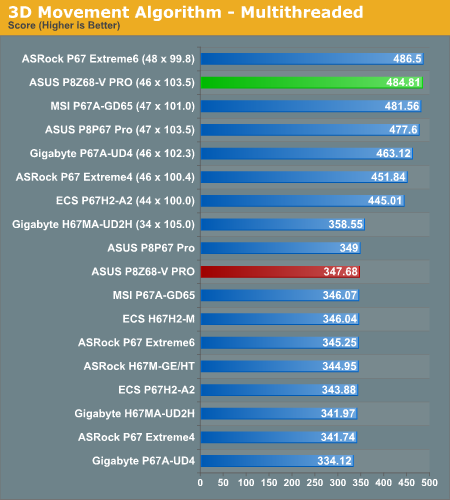
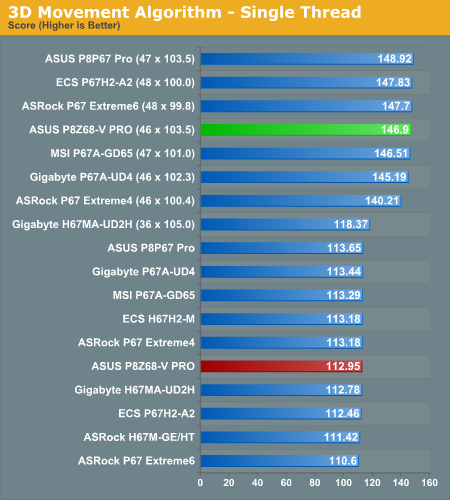
WinRAR x64 3.93
With 64-bit WinRAR, we compress the set of files used in the USB speed tests. WinRAR x64 3.93 attempts to use multithreading when possible.
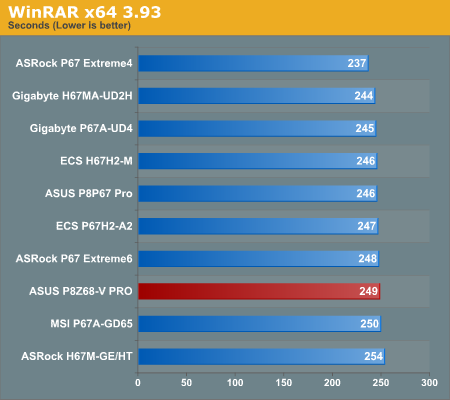
FastStone Image Viewer 4.2
FastStone Image Viewer is a free piece of software I have been using for quite a few years now. It allows quick viewing of flat images, as well as resizing, changing color depth, adding simple text or simple filters. It also has a bulk image conversion tool, which we use here. The software currently operates only in single-thread mode, which should change in later versions of the software. For this test, we convert a series of 170 files, of various resolutions, dimensions and types (of a total size of 163MB), all to the .gif format of 640x480 dimensions.
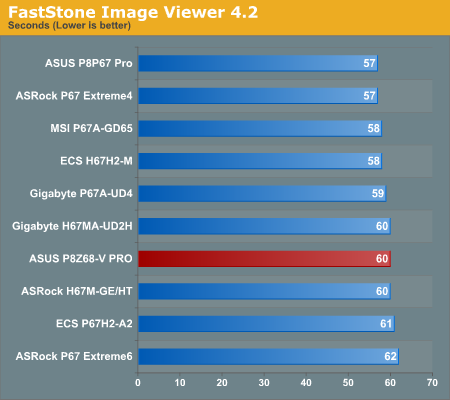
Sorenson Squeeze 6.0
Sorenson Squeeze is a professional video encoder, complete with a vast array of options. For this test, we convert 32 HD videos, each a minute long and approximately 42 MB in size, to WMV 512KBps format. Squeeze can encode multiple videos at once, one for each thread.
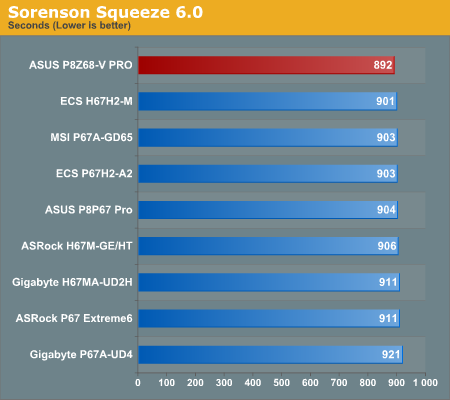
The ASUS does relatively well in our Computation bench suite, with an excellent Squeeze score. It's not the fastest board so far, but the difference between the slowest and fastest board in each test is only 3-9%, so for stock performance it's not something generally noticeable in day to day use.










95 Comments
View All Comments
L. - Thursday, May 12, 2011 - link
What you are searching for is not undervolting and underclocking, its called advanced, manually-defined "speedstep".Haven't heard of it available commercially but some guy did that for his old AMD XP and it was pretty interesting - although that chip slowed down to almost a standstill on the lowest setting.
Sunsmasher - Wednesday, May 11, 2011 - link
A board that performs well under the higher stresses of overclocking/overvolting will of course perform well in an undervolting situation. It's then up to the user (you) to find undervolting settings that work well with your particular processor.Also, it would be silly to buy a motherboard in this class (3 gpu capable, etc.), if your intention were to save as much power in your system as possible. An H67 board would probably make more sense for an undervolted "green' system. Most Anandtech readers who read reviews of boards in this class are, I sure, interested in the maximum performance available in their systems as opposed to saving energy. (Saving energy is an admirable goal, of course, just not the main priority of people who want maximum possible performance.) That's why undervolting testing is not done here, I'm sure.
gevorg - Wednesday, May 11, 2011 - link
Good point! Even when you seek high performance, low power and energy saving are still very important because your might leave your computer idle or use it for simple tasks, and its important for it to dynamically change to your needs without being an energy hog when it doesn't need to be.tomoyo - Wednesday, May 11, 2011 - link
I'd just be happy with the following data on each motherboard to make sure you have something low power and silent:1) What voltage selections you have for both under and overvolting
2) What fan speed choices you can choose.
3) What the power consumption with said motherboard is compared to similar ones at idle and load.
(It seems intel generally wins in this category at idle)
This will make it clear if you have something that is a champ for low power.
Rajinder Gill - Thursday, May 12, 2011 - link
Looking at the core voltage scale in the spec table in the article - it starts at 0.8V and also that you've got multiplier control. That means underclocking is possible.One thing that many of you are probably aware of (but some aren't) is that if you have C1E and SpeedStep active, light loading power savings due to reduced VID are so small that it's hard to measure them - certainly not with a standard plug-in AC level meter. The measurements need to be done at DC and may show that some of the potential savings may be nullified by the VRM efficiency curve if some form of load dependant phase control isn't supported by the system.
As for full loading scenarios, you can set the idle threshold percentage in Windows 7 to a higher level, thus ensuring the processor only goes into full load state under the most arduous loads. This way you get to keep the performance advantage of a higher clock freqeuncy (if and where needed), while still having the ultra low consumption courtesy of power gating through all major sections of the processor including cache (in C6 state).
In truth, to educate the masses, this properly this probably needs a separate article and followed up by a two line blurb when reviewing a motherboard to state whether the BIOS allows underclocking. That's about all there is to it in my opinion, I don't think too much time needs to be spent on the subject in subsequent reviews with the groundwork out of the way.
Regards
NeBlackCat - Friday, May 13, 2011 - link
Great post, thanks for that information.Sabresiberian - Friday, May 13, 2011 - link
Frankly, I want a high end mainboard to have no expense allocated for audio at all; I'll buy a decent solution for my sound thank you very much, please save me a few bucks to put toward that end! Or, put the money into figuring out how I can add a sound card AND have triple SLI/Crossfire. Build in a Killer NIC so I don't have to use an addon card there.Mid and low-end cards should have mid or low-end sound solutions.
;)
xinaes - Wednesday, May 11, 2011 - link
"graphics card manufacturers are pretty good on low power states"... unless you connect more than one display, in which case they apparently push cards into 3d clock speeds constantly:http://www.silentpcreview.com/forums/viewtopic.php...
I'd like to know if boards such as this will let me run two displays off the IGP with Virtu in i-mode, how much power that would consume, also what the hit would be on performance under different circumstances. I'm hopeful that the IGP might be able to drive both displays without using substantial amounts of power for basic tasks, and that the performance cost in more demanding situations while appreciable would not be crippling.
Krenn - Wednesday, May 11, 2011 - link
That's an excellent question - I'd love to see the same thing. I usually use two monitors for basic tasks and only one for gaming, but would like to save power without having to unplug & switch the monitor cables. Also, I had no idea running two monitors from the same video card was using more power than it should; that could definitely make a difference.I assume you can't mix and match and connect one monitor to the integrated and the other to the discrete and use both monitors at the same time.
xinaes - Wednesday, May 11, 2011 - link
I'm not sure exactly what mixing and matching is possible. Something that was posited as a workaround in the thread I linked (in the context of systems where IGP is not available) is using a second low power GPU to drive the secondary display. It may well be that the IGP could fill a similar role with a Z68 board, but it's hard to be sure.For me it would be irritating as I don't only use the graphics for gaming on a single screen; I'd want at times to run 3d apps with resources shared by windows on both screens etc. Still, I'd like to at least have the option of such a workaround if it meant saving power, even if it was irritating in certain circumstances.